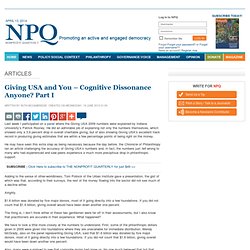

2012 Philanthropy and Social Investment Industry Report Now Available. For the past three years, my colleague Lucy Bernholz has published her annual Philanthropy and Social Investing: Blueprint, an industry forecast about the social economy – private capital used for public good.

Each year it provides an overview of the current landscape, points to major trends, and directs your attention to horizons where you can expect some important breakthroughs in the coming year. The 2012 blueprint is now available and it is well worth time to read. Lucy Bernholz is a self-described a philanthropy wonk who has been working in, consulting to, and writing about philanthropy and the social economy since 1990. She writes the definitive blog on the topic called Philanthropy 2172. She’s currrently a visiting scholar at Stanford University’s Center on Philanthropy and Civil Society. What Denominations Take Tithing Most Seriously? January 31, 2011; Source: Christianity Today | How much of your income do you devote to charitable giving?

According to emptytomb.org, Christians donated 2.43 percent of their income in 2008, down from 2.57 percent in 2007. Evangelicals give an estimated 4 percent. Those are solid proportions compared to all Americans, but less than a 10 percent tithe. Who Gives, Why do They Give, How do They Give to Nonprofits? NEW YORK, Aug. 24 /PRNewswire/ -- A new research study was released Tuesday that may change the way many nonprofits approach their fundraising budgets.
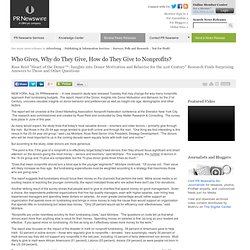
The report, Heart of the Donor, Insights into Donor Motivation and Behavior for the 21st Century, uncovers valuable insights on donor behavior and preferences as well as insight into age, demographic and other factors. The report will be unveiled at the Direct Marketing Association Nonprofit Federation conference at the Sheraton New York City. What Do Donors Want? When Sigmund Freud asked, “What do women want?”
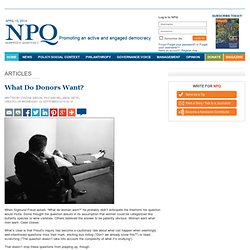
He probably didn’t anticipate the firestorm his question would incite. Some thought the question absurd in its assumption that women could be categorized like butterfly species or wine varietals. Others believed the answer to be patently obvious: Women want what men want. 2010 Fundraising Survey Results: The Worst May Be Over. Article - Nonprofits in Rural America: Overcoming the Resource Gap.
Download PDF Author(s): Barry Newstead, Pat Wu Published Date: July 15, 2009 “There’s a Norman Rockwell picture of rural America: white picket fences, everyone goes to church, and everyone helps the person next door.

A great deal of that is true, but poverty is not seen in rural areas. Behind all those things, there is a great deal of poverty.”[1] The depiction of poverty in America has changed dramatically over the past hundred years as our nation has transformed into a largely urban, post-industrial economy. Microsoft Employees Give Big. January 14, 2011; Source: Seattle Times | In Microsoft’s 2010 workplace giving campaign, 35,000 employees (out of 53,635 in the U.S.) made charitable contributions.

The company matched employee contributions dollar for dollar up to $12,000 per employee and paid an hourly match for employees who volunteered with charities (4,000 employed dedicated 350,000 hours to volunteer work, which generated $6 million in Microsoft company contributions to the recipient charities). The total of all of this was a $96 million campaign that gave money to 16,000 nonprofits.
The top three recipients were the United Way of King County (Washington), World Vision International, and the Seattle Children's Hospital Foundation. Microsoft employees constitute the largest source of donors for the Children's Hospital, with most of the funds dedicated to paying for the uncompensated health care costs of patients lacking health insurance. Giving USA and You – Cognitive Dissonance Anyone? Part II. When the Giving USA Foundation and the Center on Philanthropy at Indiana University released their annual tabulation of charitable giving in the United States last Wednesday the numbers raised as many questions as they answered—and felt to us counterintuitive in many ways.
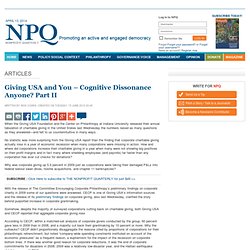
No statistic was more surprising from the Giving USA report than the finding that corporate charitable giving actually rose in a year of economic recession when many corporations were missing in action. How and where did corporations increase their charitable giving in a year when many were not showing big positives on their profit margins and in fact many where shedding employees (and payrolls) far faster than any corporation has ever cut checks for donations? Dispensing Dirty Water. How Did Giving Fare Last Year? - Giving USA. By Holly Hall The economy struck another blow to charitable donations last year, causing contributions from foundations, corporations, and individuals to decline by 3.2 percent, according to Giving USA, the annual tally of American philanthropy released this morning.
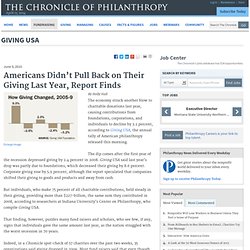
The dip comes after the first year of the recession depressed giving by 2.4 percent in 2008. Giving USA said last year’s drop was partly due to foundations, which decreased their giving by 8.6 percent. Corporate giving rose by 5.9 percent, although the report speculated that companies shifted their giving to goods and products and away from cash. Future Givers are Created Not Born.
Giving USA 2010 executive summary. Giving USA and You – Cognitive Dissonance Anyone? Part I. Last week I participated on a panel where the Giving USA 2009 numbers were explained by Indiana University’s Patrick Rooney.
